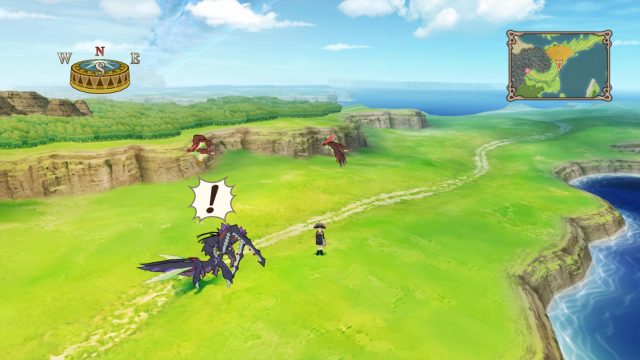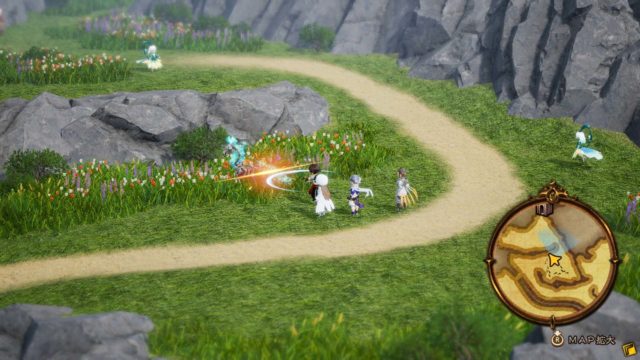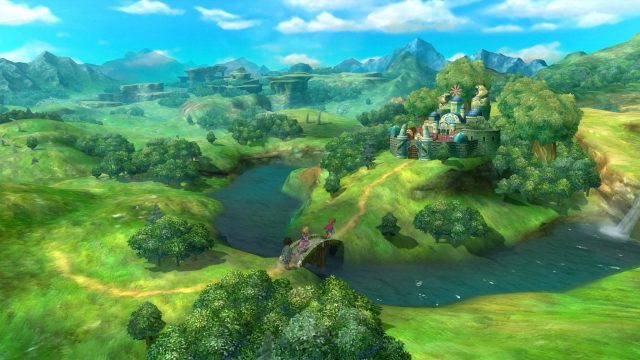Ode to the Overworld
These days, games with open worlds might be in vogue, but overworlds aren’t over with yet. To this day, players venture across them. Traversing a scaled down version of a game’s huge world is often necessary, or at least it was. Once a staple in RPGs, the overworld is threatened to become a relic; Tales of Vesperia features one of the last great ones in its series, as subsequent titles have primarily gone down the route of interlocked fields. Today’s full open-world environments may not need such an overarching travel element, but some modern titles still utilize travel as a theme. An overworld unifies separate gameplay areas, brings cohesion to a story’s overall setting, and adds an interactive layer for exploration. So it shouldn’t be overlooked or underappreciated. I imagine many RPGamers like myself enjoy a good overworld.

In Tales of Vesperia, players traverse an essential overworld, fight monsters there, and avoid getting lost with a mini-map and compass on top.
Modernized games may obviate the overworld, but traditional JRPG’s are defined by one. For example, in Bitmap Books’ A Guide To Japanese Role-Playing Games, its broad definition of a JRPG includes,
“an overworld that is divided into discrete town and dungeon sections…”
In other words, classic role-playing games are known partly for this interactive and interconnecting game design element. It gives players a cohesive and tangible view of the game’s scope and setting, making it a central and thus essential part of an RPG.
Despite being a defining feature, RPGs at some point began to replace them. Final Fantasy X is a noteworthy example, featuring an almost linear 3D path throughout the game, tossing the overworld overboard. Though commercially successful, it was a somewhat controversial design choice; some players thought the omission was a detriment to the game. Very late in its story, the title did finally provide a simple paper-like map. While better than nothing, it’s not the same as a traversable world map. It’s likely that some gamers think FFX would have been better if it had one, much like previous titles in the series.
One such previous title, Final Fantasy VI (released in North America on the Super Nintendo as Final Fantasy III), was my first venture on an RPG overworld. It was displayed in the Super NES’s Mode 7 graphics, which made travel more engrossing by letting players rotate the map plane a full 360 degrees. The world map gave me a feeling of adventure as my character walked between towns and caves across different geographic areas. When I witnessed — spoiler alert — Figaro Castle submerge in the sandy desert, I was totally surprised to see its world map sprite sink beneath pixel dust! Topping that, it amazed me later in the game when the balanced overworld was drastically ruined — that visual was a night and day difference. And not only did I see it, I could traverse its twisted alteration. Such a world-change made me feel the weight of its tragedy. FFVI’s late-game world map was in stark contrast to what it started with early on.
This Final Fantasy VI overworld is in Mode 7, letting players fly in all directions, with the mini-map providing location reference.
Speaking of timing, reaching the overworld early in an RPG is often better than late since the world map is foundational to a game’s setting. Sometimes, though, it can be effective to do otherwise. Case in point, the entirety of disc one for Final Fantasy VII is played before reaching the world map. I spent several hours in Midgar’s fragmented areas — Sector 7 Slums, Train Graveyard, Wall Market, Shinra Headquarters — and didn’t have a clear mental picture of how it all fit together; it was a bit disorienting.
When I eventually arrived on the world map, I saw the city of Midgar in relation to the world and only then felt the game open up — albeit after several gameplay hours. Although this didn’t clarify the layout of Midgar’s various internal sections, I at least was able to get a sense of where other towns and dungeons were in relation to Midgar. And finally in the overworld, I was more eager to explore the game’s unfolding story, chasing Sephiroth from one point to the next. Well, that and fetching Gysahl Greens to catch a Chocobo, whose tracks were clearly evident on the ground of the world map.
Unlike FFVII’s much delayed overworld, Bravely Default II — a modern RPG — presents the world map at its beginning. Ideally, the sooner players see a game’s sweeping setting, the easier it is to grasp the story’s big picture. Early access to it often necessitates that many areas are obscured by clouds or shadows, but this fuels curiosity and urges continued exploration to advance the game.
Bravely Default II is a good example of overworld interaction. As players travel over the world map, they engage visible enemies, find hidden items by chopping down foliage, and discover remote locations. This makes gameplay more interesting than merely checking a traditional static map for directions. So an overworld is more than a means between waypoints; it’s both part of the journey and a destination unto itself. That said, Bravely Default II also utilizes a classic 2D reference map for town and sidequest markers, plus it employs a simplified mini-map overlaying the world map. Altogether, these let players sufficiently navigate the game.

Bravely‘s overworld looks lively and presents solid gameplay interaction. It even uses a mini-map overlay.
Along with interaction, Bravely Default II’s overworld exemplifies great presentation. Since RPGs often feature repetitive overworld theme music, it should sound pleasing to the ears. BDII checks that box with its delightful and clever tune. What makes it noteworthy are the varied renditions, which sound expertly done and avoid boring repetition. As described by RPGamer’s own Anna Marie Privitere in her review:
“The gorgeous overworld theme is reworked each time the player moves to a new location, with an instrument matching the theme of each region taking the dominant role.”
Not only does it sound great, Bravely’s overworld also looks great. The vivid terrain varies with bright colors, elevation changes, winding pathways, flowing mists, tainted waterways, and more. But I think a greater example of overworld visual presentation is the lovely one in Ni no Kuni: Wrath of the White Witch. It’s a sight to behold, saturated with lush details and making good use of Studio Ghibli’s art style, warranting the superlative, “splendid.” Each of its biomes — desert, volcano, swamp, forest, meadow, or tundra — are visually distinct, vibrant, and use animated details like sparkling water, steaming lava, or wispy wind currents, which clearly convey the inviting fantasy and sprawling scope of Ni no Kuni’s “other world.”

The overworld in Ni no Kuni‘s “other world” borders on sublime, with lush looking storybook visuals and varied terrain.
As a genre-defining feature when it appears, RPGamers deserve a well designed overworld. When a game’s story unfolds like a good map, its overworld should too, and it’s best when presented and interacted with early in the adventure. From the start, overworld presentation should be aurally and visually excellent. As an essential element, if an overworld arrives late in an RPG, fails to offer robust exploration, looks bland, or is plagued with repetitive theme music, then both gameplay and story — and ultimately players — suffer. Maybe today’s modernized titles can get by without one, but I’m not getting over the overworld.







Thank you for writing this! I’ve always felt this way and figured I must be the only one. I also didn’t know this about Bravely Default 2 and will definitely be checking that out!
BTW, if you haven’t already, join the RPGamer Discord where you can chat with others about overworlds and all the RPG goodness you want 🙂 Thanks!
Thanks for reading, LantsInPance, glad you like it. I’m sure there are many more who enjoy escaping into a good RPG overworld. I’m happy that modern titles still utilize them. To me, they’re classic elements that make a JRPG feel more like…a JRPG. And yes, BDII has a great overworld, among other things; maybe it’s quaint…but it’s quality. If you like RPGs that have roots or inspiration from the 90s, I think BDII is worth all its gameplay hours.